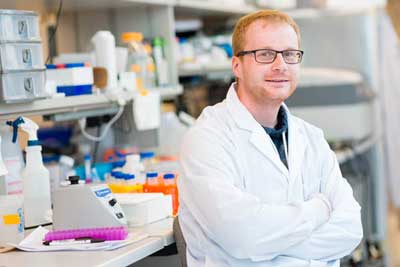| Posted: Apr 27, 2016 |
How many nanoparticle-based drugs reach tumours? Less than one per cent
(Nanowerk News) Targeting cancer cells for destruction while leaving healthy cells alone — that has been the promise of the emerging field of cancer nanomedicine. But a new meta-analysis from U of T’s Institute of Biomaterials & Biomedical Engineering (IBBME) indicates that progress so far has been limited and new strategies are needed if the promise is to become reality.
|
|
“The amount of research into using engineered nanoparticles to deliver cancer drugs directly to tumours has been growing steadily over the last decade, but there are very few formulations used in patients. The question is why?” says Professor Warren Chan (IBBME, ChemE, MSE), senior author on the review paper published in Nature Reviews Materials ("Analysis of nanoparticle delivery to tumours"). “We felt it was time to look at the field more closely.”
|
 |
| Stefan Wilhelm is the lead author of a new review paper that shows less than one per cent of designer nanoparticles actually reach their intended target.
|
|
Chan and his co-authors analysed 117 published papers that recorded the delivery efficiency of various nanoparticles to tumours — that is, the percentage of injected nanoparticles that actually reach their intended target. To their surprise, they found that the median value was about 0.7 per cent of injected nanoparticles reaching their targets, and that this number has not changed for the last ten years. “If the nanoparticles do not get delivered to the tumour, they cannot work as designed for many nanomedicines,” says Chan.
|
|
Even more surprising was that altering nanoparticles themselves made little difference in the net delivery efficiency. “Researchers have tried different materials and nanoparticle sizes, different surface coatings, different shapes, but all these variations lead to no difference, or only small differences,” says Stefan Wilhelm, a post-doctoral researcher in Chan’s lab and lead author of the paper. “These results suggest that we have to think more about the biology and the mechanisms that are involved in the delivery process rather than just changing characteristics of nanoparticles themselves.”
|
|
Wilhelm points out that nanoparticles do have some advantages. Unlike chemotherapy drugs which go everywhere in the body, drugs delivered by nanoparticles accumulate more in some organs and less in others. This can be beneficial: for example, one current treatment uses nanoparticles called liposomes to encapsulate the cancer drug doxorubicin.
|
|
This encapsulation reduces the accumulation of doxorubicin in the heart, thereby reducing cardiotoxicity compared with administering the drug on its own.
|
|
Unfortunately, the majority of injected nanoparticles, including liposomes, end up in the liver, spleen and kidneys, which is logical since the job of these organs is to clear foreign substances and poisons from the blood. This suggests that in order to prevent nanoparticles from being filtered out of the blood before they reach the target tumour, researchers may have to control the interactions of those organs with nanoparticles.
|
|
It may be that there is an optimal particle surface chemistry, size, or shape required to access each type of organ or tissue. One strategy the authors are pursuing involves engineering nanoparticles that can dynamically respond to conditions in the body by altering their surfaces or other properties, much like proteins do in nature. This may help them to avoid being filtered out by organs such as the liver, but at the same time to have the optimal properties needed to enter tumors.
|
|
More generally, the authors argue that, in order to increase nanoparticle delivery efficiency, a systematic and coordinated long-term strategy is necessary. To build a strong foundation for the field of cancer nanomedicine, researchers will need to understand a lot more about the interactions between nanoparticles and the body’s various organs than they do today. To this end, Chan’s lab has developed techniques to visualize these interactions across whole organs using 3D optical microscopy, a study published in ACS Nano this week ("Three-Dimensional Optical Mapping of Nanoparticle Distribution in Intact Tissues").
|
|
In addition to this, the team has set up an open online database, called the Cancer Nanomedicine Repository that will enable the collection and analysis of data on nanoparticle delivery efficiency from any study, no matter where it is published. The team has already uploaded the data gathered for the latest paper, but when the database goes live in June, researchers from all over the world will be able to add their data and conduct real-time analysis for their particular area of interest.
|
|
“It is a big challenge to collect and find ways to summarize data from a decade of research but this article will be immensely useful to researchers in the field,” says Professor Julie Audet (IBBME), a collaborator on the study.
|
|
Wilhelm says there is a long way to go in order to improve the clinical translation of cancer nanomedicines, but he’s optimistic about the results. “From the first publication on liposomes in 1965 to when they were first approved for use in treating cancer, it took 30 years,” he says. “In 2016, we already have a lot of data, so there’s a chance that the translation of new cancer nanomedicines for clinical use could go much faster this time. Our meta-analysis provides a ‘reality’ check of the current state of cancer nanomedicine and identifies the specific areas of research that need to be investigated to ensure that there will be a rapid clinical translation of nanomedicine developments.”
|

